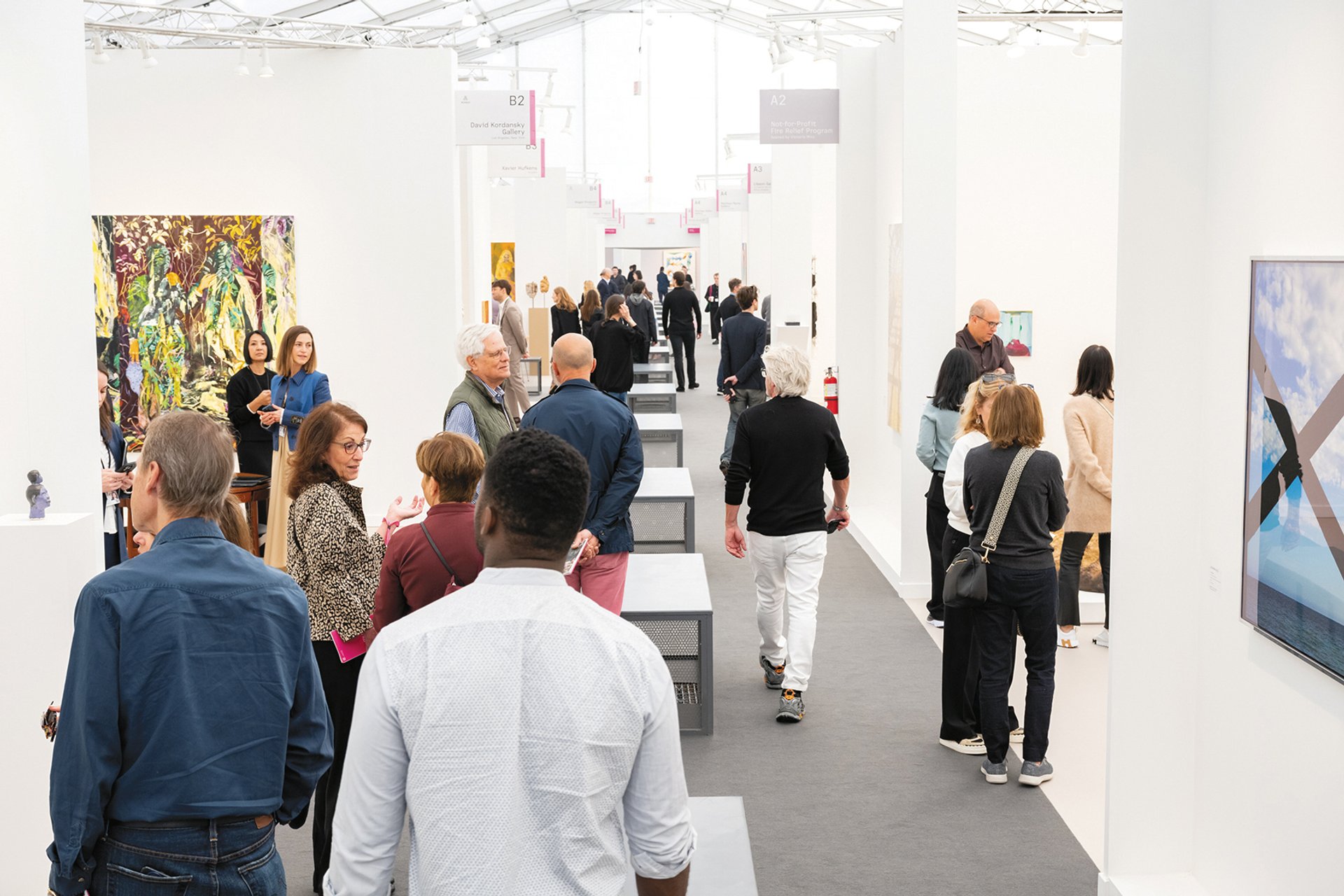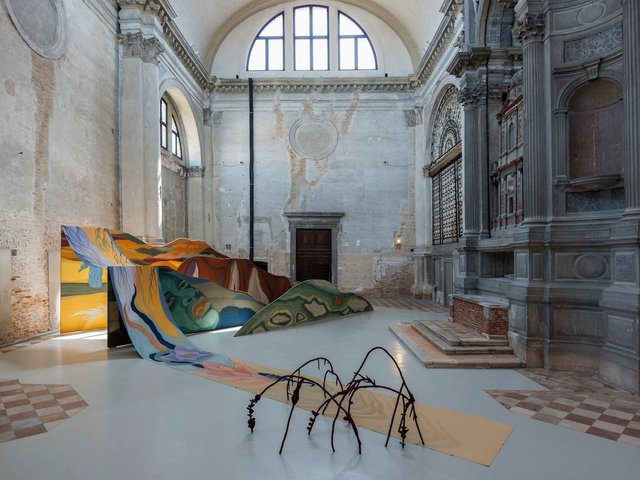As temporary ventures, art fairs face several challenges in terms of sustainability, which vary based on the event. Untitled Art in Miami Beach, for example, takes place directly on the beach in a temporary tent. For sustainability and cost purposes, the fair reuses the same tent each year but constructs new auxiliary spaces, like VIP lounges. Untitled Art works with municipal and state environmental departments to ensure the fair leaves “zero impact” on the fragile, eroding sands of Miami Beach, meaning that once the fair is over, the beach must be left the same way it was found.
Fairs held inside existing structures have their own set of challenges, including building temporary walls, installing energy-consuming lighting and dealing with waste from exhibitors and attendees. Some fairs are held in buildings with specific sustainability requirements that they must adhere to, such as Art Basel Miami Beach in the Miami Beach Convention Center, which holds the level of silver on the Leadership in Energy and Environmental Design (LEED) rating system. The global programme assesses buildings’ energy efficiency, as well as environmental, governance and social benefits on a four-tiered scale, with silver as the third-highest ranking.

Flight risk: most visitors to major art fairs are likely to have flown in—the wealthiest by private jet Casey Kelbaugh/CKA
As an art-fair exhibitor, it can be difficult for a gallery to maintain climate-conscious standards. According to the Gallery Climate Coalition (GCC), art fair-related activities are estimated to account for a third of the annual carbon emissions for a commercial gallery. Waste reduction is also difficult at fairs, as some of the packing materials needed to ship art may not be able to be stored during the fair for reuse after.
Making sustainable decisions on shipping in general can be challenging. For some dealers, fairs are an opportunity to display an artist’s newest pieces, which can mean the artist is still working on them close to opening day. This would make more climate-conscious options like road, ocean or rail freight impossible, as they are slower and require longer lead times. In general, because these methods of transport demand a more flexible timeline to account for delays (in particular ocean freight’s susceptibility to inclement weather and customs setbacks), they are often challenging for exhibitors to use for art fairs, which require more precise shipping deadlines. This does not mean it is impossible to implement best practices, but there are significant roadblocks. Shipping companies are working to support exhibitors in this respect, with most of the major companies that participated in GCC’s 2023 shipper survey reporting that they currently publish or are in the process of promoting deadlines for sea and road shipments for major fairs and events.
Amplifying these issues is the highly competitive nature of art fairs. Paranoia around shipping a hypothetical $20m painting by air to France for potential sale is tenfold when the destination is a fair, where the high costs of participation (booth fees, shipping, flights, accommodations and meals) add to the pressure to make sales. Galleries do not want to share what they are bringing with each other in advance, and some of the works shipped to fairs are intended for private viewing rooms, so dealers might book private shuttles instead of joining a consolidated shipment. The sense of urgency and secrecy can be heightened by last-minute decisions to add high-value consignments or unexpected works fresh from a studio that require expedited shipping.
Packing up and out
Planning for the return trip from a fair can be even trickier, as exhibitors do not know the final destination of the works until they are sold—or if they even will sell. When the event ends, stands are quickly deinstalled so that fair organisers can take down temporary walls and clear out the spaces they themselves are only renting. The post-fair activities are, therefore, expedited. Some of the works that were shown may have been pre-sold and their shipments determined in advance, but in general planning has to be flexible.
There are nuances with each fair and each exhibitor. Some galleries might have locations near the fair or the resources to rent space in a nearby storage facility, giving them extra time after the fair to receive payments from collectors and coordinate shipping. Other galleries might not have the money for these kinds of accommodations and need to quickly arrange for works to travel to their buyers on the hoof. This transfer of goods and ownership can be a grey area for sustainability. And, of course, works that are not sold must travel somewhere after the fair, whether that is back to the gallery, the artist’s studio or storage.
On top of this, art fairs require many people to fly across the country and the world to staff the stands. Art Basel’s 2024 edition in Switzerland featured 285 galleries from more than 40 countries and territories. It is safe to assume that multiple staff from each gallery travelled to Basel, most of them likely on international flights. The same event saw 91,000 visitors in attendance. While this number hopefully comprises a large share of local audiences, it is undeniable that numerous flights were taken. For its part, Art Basel is attempting to account for these factors. The fair encourages low-carbon travel and asks shippers to specify the distances, means of transport and weight of works in order to better understand the environmental impact of its partners and collaborators.
Despite their best efforts to encourage climate-conscious, low-carbon travel, art fairs are not in control of the behaviour of exhibitors and attendees, some of whom will undoubtedly be wealthy individuals accustomed to flying privately. A 2023 study by the UK charity Possible indicates that the use of private jets increased significantly after the Covid-19 pandemic, with one out of every ten flights departing from UK airports being a private plane. It is well documented that private jets have a significant carbon footprint—as much as ten times more than a commercial flight per person, according to Greenpeace.
As The Art Newspaper’s Louisa Buck has noted, the use of private planes in the art world is widely known, as the industry’s close connections with the world’s wealthiest people gives ample access to private jets. One mega-gallery owner has admitted to using his plane to fly between the gallery’s 19 locations worldwide. Buck also points to the presence of private-jet companies at art fairs, including official partnerships between NetJets and Art Basel, as well as VistaJet and Frieze, though the latter relationship has ended. While it is unlikely that galleries will police their clients’ activities and refuse to sell to private fliers, they can at least ban the use of private planes for company activities, and fairs can ask the same of their partners. However, it is hard to imagine that anyone would be willing to tell their mega-dealer boss to fly commercial.
• This is an excerpt from Climate Action in the Art World: Towards a Greener Future by Annabel Keenan, available from Lund Humphries and Sotheby’s Institute of Art on 29 May in the UK and 1 September in the US






